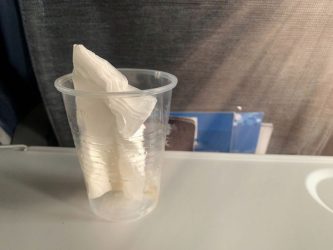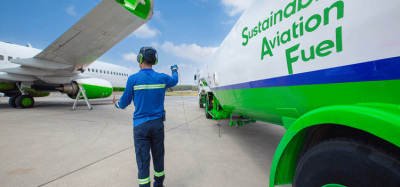Resource recovery in a post-COVID-19 pathogen world
- Like
- Digg
- Del
- Tumblr
- VKontakte
- Buffer
- Love This
- Odnoklassniki
- Meneame
- Blogger
- Amazon
- Yahoo Mail
- Gmail
- AOL
- Newsvine
- HackerNews
- Evernote
- MySpace
- Mail.ru
- Viadeo
- Line
- Comments
- Yummly
- SMS
- Viber
- Telegram
- Subscribe
- Skype
- Facebook Messenger
- Kakao
- LiveJournal
- Yammer
- Edgar
- Fintel
- Mix
- Instapaper
- Copy Link
Posted: 27 May 2020 | Gregoire James - International Aviation Waste Management Association (IAWMA) | No comments yet
Gregoire James from the International Aviation Waste Management Association (IAWMA) details the negative impacts safety measures against COVID-19 may have on the environment and asks what will waste-resource recovery look like in the future?


The year was 1974. Dr. Halfdan Mahler – the World Health Organization’s Director General at the time – identified a need to ensure the safety of food, water and waste derived from the increased activity of international travel. That year, passenger numbers hovered around 420 million. With annual passenger growth projections continuing to rise exponentially (passenger numbers peaked in 2019 at 20 times what they were in 1974), and along with it the amount of resultant garbage generated by these volumes, new action was needed. The outcome of these activities went on to produce the second edition of the Guide to Hygiene and Sanitation in Aviation in 1977 (WHO, 2009).
Single-use plastics have made a roaring comeback with volumes increasing significantly over pandemic fears
Informed by this guide and advised to work with local health authorities, the air transport industry started to develop new waste handling practices and public health protection measures. Imagining worse-case pest or pathogen contamination scenarios arriving at their international airports, each country reacted to protecting their own by developing material offloading, treatment and disposal regulatory policies. These stringent material handling procedures were born out of necessity for the protection of native plant and animal life (flora/fauna) in each country.
More aptly stated, these measures were put in place for the health and wellbeing of our shared environment and for the intrinsically connected people who live in it. For example, should a food source become contaminated, it may well prevent its export and import. The United States Department of Agriculture’s (USDA) first case involving contaminated livestock occurred over 100 years ago. Europe had placed a ban on the importation of U.S. meat. An investigation concluded more attention was needed for the control and prevention of livestock diseases (USDA, APHIS, 2012). Since that time, the U.S. Department of Agriculture has been developing and enforcing agricultural regulations to prevent harmful insects and microorganisms from entering the country.
The garbage and waste from COVID-19
Before the dramatic shock to air travel passenger demand as a result of the current global health pandemic, airlines and airports were focused on delivering on their climate change and waste strategies. With the rapid decline in traffic movements, the 24-hour news cycle is touting stories about how our planet is benefitting. But where do we go from here?


In an early response to COVID-19, many airlines drastically reduced their in-flight beverage service, if not scrapping it altogether. They removed reusable mugs and wine glasses and began handing out in a hurry, food bags with the basic sustenance most passengers need over a medium to long flight duration. These seemingly innocuous cabin service changes may not have come without a potentially harmful impact on the landfills that airports depend on. Unfortunately, there is measurably more additional packaging on everything now, solely intended to mitigate pathogen transmission risk to the consumer.
Given the continued pervasiveness of COVID-19 and the need to adapt to its presence long-term, there are signs that some airlines may be pausing their passenger cabin service delivery all together. But is that necessary? Catering facilities already adhere to strict food safety protocols. To ensure safe supply chains, caterers adhere to programmes such as the Hazard Analysis and Critical Control Point (HACCP) certification reducing biochemical risk and ISO 22000.
Reusability may still be the best way for airlines and airports to reduce waste, increase sterility and decrease costs
Perhaps, passengers could bring food and beverages from airports or from en route sources. While this option may reduce touchpoint risk, it will invariably increase the overall amount of landfill waste while detrimentally impacting existing recycling programmes by contributing more to previously unidentifiable waste streams. Additionally, attempts by passengers to bring their own food and beverages may get rejected at screening security due to strict importation requirements or onboard container size limitations. Airlines and airports will, therefore, have to strike a balance between biosecurity and the passenger experience. More packaging, hence, may be the only immediate option, together with a continuation of the previously limited amount of recyclable recovery to ensure a pathogen-free experience.
Redesigning supply chains
In nature, almost every plant and animal produce waste, and the environment is optimised to process it effectively. For humans to deliver verifiable risk-mitigated sterility, supply chains will have to find new ways to handle our garbage and mimic nature’s efficiency. Adoption and integration of more intelligent procurement and supply chain practices are needed now to shape future waste recovery efforts.
Theoretically speaking, advanced procurement mechanisms could increase recyclable end-of-life recovery (through redesign). At present, reusability may still be the best way for airlines and airports to reduce waste, increase sterility and decrease costs. For example, biodegradable products, once thought before the current pandemic to be a truly viable solution, don’t biodegrade in all commercial facilities.


Post COVID-19 may require new recovery standards.
If current conditions warrant the retooling and redesigning of supply chains for more comprehensive food delivery safety, it might also usher in a new era of recovery standards. In a post-COVID world, the industry could come together not only for resource recovery but perhaps for streamlining the sterile product delivery too.
For example, aluminium beverage cans are widely used across supply chains today. They are recoverable and recycled on mass (sometimes even skirting policy requirements preventing their recapture). Perhaps, beverage can solutions with a peel-off top layer (at the can opening) could provide for the elimination of a one passenger specific touchpoint. In the post-COVID world, passengers may not desire separate drink cups, but they might be okay with a container not exposed to any previous physical touch. These small changes will add up. Less disposable cup waste, reduction of fluid contamination from ice in the waste bag and an increase in the likelihood the aluminium from cans will be reused.
Today, as a result of the current pandemic, we have gained novel and sobering knowledge of potential outcomes caused by worst-case scenarios. Ask yourself: What if some of the standards outlined here were in place before it started? How will the air transport industry adjust to a new normal and what will waste-resource recovery look like in the future or more to the point, will it no longer exist?
Biography
Gregoire James is currently the Commercial Director of the International Aviation Waste Management Association (IAWMA) with over 10 years of experience in the recycling industry, featuring an extensive background in advisory roles for various brands around materials recovery. Most recently, he conducted a global multi-year FAA-funded study for the Airport Cooperative Research Program (ACRP), which reviewed policy, regulations and practices as it pertains to the recovery of international recyclables from in-flight services.
Related topics
COVID-19, Regulation and Legislation, Sustainability, Sustainable development


















